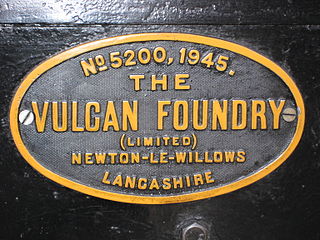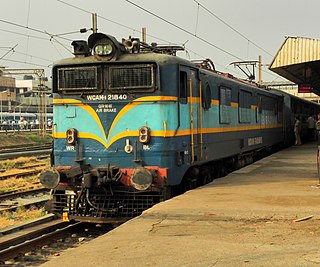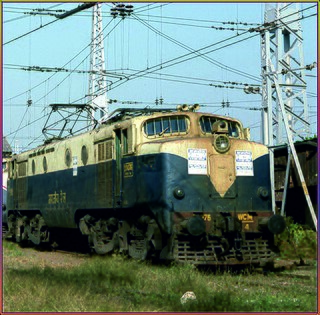
The Vulcan Foundry Limited was an English locomotive builder sited at Newton-le-Willows, Lancashire.

The 12123 / 12124 Deccan Queen is a daily Indian passenger train service operated by the Central Railway zone of the Indian Railways connecting the cities of Mumbai and Pune. Introduced on June 1, 1930, the Deccan Queen was India's "first superfast train, first long-distance electric-hauled train, first vestibuled train, the first train to have a ‘women-only’ car, and the first train to feature a dining car". The service name comes from the Marathi nickname "दख्खन ची राणी", a popular nickname for Pune. Deccan Queen is currently the fastest train service linking Chhatrapati Shivaji Maharaj Terminus and Pune Junction. It has an average operating speed of 60 km/h (37 mph) including stops, and a top speed of 105 km/h (65 mph). The train's long history and common use as a commuter train has gained it significant popularity, including annual celebrations of its "birthday" on June 1 at Pune Junction. It was hauled by a Kalyan-based WCAM-3 end to end up until June 2022. From June 2022, its upgraded coaches in a new livery are being hauled by a Ajni-based WAP-7.

The Indian locomotive class WCAM-1 is a class of Bi-current electric locomotives that was developed in 1973 by Chittaranjan Locomotive Works for Indian Railways. The model name stands for broad gauge (W), DC Current (C), AC Current (A), Mixed traffic (M) locomotive, 1st generation (1). They entered service in March 1973. A total of 53 WCAM-1 were built at CLW between 1973 and 1979, which made them the most numerous class of mainline dual-power AC-DC electric locomotive.

The Indian locomotive class WDM-4 is a class of diesel-electric locomotive that was developed in 1962 by Electro-Motive Diesel for Indian Railways. The model name stands for broad gauge (W), Diesel (D), Mixed traffic (M) engine, 4th generation (4). They entered service in 1962. A total of 72 WDM-4 locomotives were built between 1961 and 1962.

The Mumbai Dadar–Solapur section is part of the Mumbai–Chennai line. It connects Mumbai Dadar and Solapur both in the Indian state of Maharashtra.

The Indian locomotive class WCAM–3 is a class of dual-power AC/DC series electric locomotives That was developed in 1997 by Bharat Heavy Electricals Limited used in the Indian Railways system. They are the third locomotives from the WCAM class. The model name stands for broad gauge (W), DC Current (C), AC Current (A), Mixed traffic (M) locomotive, 3rd generation (3). They entered service in 1997. A total of 53 WCAM-3 were built at BHEL between 1997 and 1998, which made them the most numerous class of mainline dual-power AC-DC electric locomotive. They were specifically designed for use by Central Railways in the Ghat section towards Nashik and Pune.

The Indian locomotive class WCG-2 is a class of 1.5 kV DC electric locomotives that was developed in the late 1960s by Research Design and Standards Organisation (RDSO) and Chittaranjan Locomotive Works (CLW) for Indian Railways. The model name stands for broad gauge (W), DC Current (C), Goods traffic (G) engine, 2nd generation (2). They entered service in February 1971. A total of 57 WCG-2 were built at CLW between 1978 and 1983, which made them the most numerous class of DC electric locomotive.
The Indian locomotive class WCAG–1 is a class of dual-power AC/DC series locomotives used in the Indian Railways system. They are the only class of the WCAG locomotives. They were specifically designed for use by Central Railways in the Ghat section towards Nashik and Pune.

The Indian locomotive class YDM-5 is a class of diesel-electric locomotive that was developed in 1964 by General Motors (GM-EMD) for Indian Railways. The model name stands for Metre gauge (Y), Diesel (D), Mixed traffic (M) engine, 5th generation (5). They entered service in 1964. A total of 25 YDM-5 locomotives was built between 1963 and 1964.
The Indian locomotive class WCM-6 is a class of 1.5 kV DC electric locomotives that was developed in 1995 by Chittaranjan Locomotive Works (CLW) for Indian Railways. The model name stands for broad gauge (W), Direct Current (C), Mixed traffic (M) engine, 6th generation (6). They entered service in 1996. A total of 2 WCM-6 locomotives was built at CLW in 1995. Currently they haul only departmental trains and do shunting duties.

The Indian locomotive class WCM-5 is a class of 1.5 kV DC electric locomotives that was developed in 1956 by Chittaranjan Locomotive Works (CLW) for Indian Railways. The model name stands for broad gauge (W), Direct Current (C), Mixed traffic (M) engine, 5th generation (5). The trains were the first locomotive of any kind fully developed and built in India. They entered service in 1961. A total of 21 WCM-5 locomotives was built at CLW between 1961 and 1963.

The Indian locomotive class WCM-4 is a class of 1.5 kV DC electric locomotives that was developed in 1956 by Vulcan Foundry and English Electric for Indian Railways. The model name stands for broad gauge (W), Direct Current (C), Mixed traffic (M) engine, 4th generation (4). They entered service in 1961. A total of 7 WCM-4 locomotives was built at England between 1956 and 1957.

The Indian locomotive class WCG-1 is a class of 1.5 kV DC electric locomotives that was developed in the late 1920s by Vulcan Foundry and Swiss Locomotive and Machine Works (SLM for Indian Railways. The model name stands for broad gauge, Direct Current, Freight traffic engine, 1st generation. They entered service in 1930. A total of 41 WCG-1 was built at England between 1928 and 1929.

The Indian locomotive class WCM-2 is a class of 1.5 kV DC electric locomotives that was developed in 1956 by Vulcan Foundry and English Electric for Indian Railways. The model name stands for broad gauge (W), Direct Current (C), Mixed traffic (M) engine, 2nd generation (2). They entered service in 1957. A total of 12 WCM-2 locomotives were built in England between 1956 and 1957.

The Indian locomotive class WCM-3 is a class of 1.5 kV DC electric locomotives that was developed in 1958 by Hitachi for Indian Railways. The model name stands for broad gauge (W), Direct Current (C), Mixed traffic (M) engine, 3rd generation (3). They entered service in 1958. A total of 3 WCM-3 locomotives were built in Japan in 1958.
The Indian locomotive class WAG-8 is a class of 25 kV AC electric locomotives that was developed in the early 1990s by Bharat Heavy Electricals Limited (BHEL) for Indian Railways. The model name stands for broad gauge (W), AC current (A), freight/goods traffic (G), eighth-generation (8). Only two units of this class were built, both prototypes.

The Indian locomotive class WCP-1 is a class of 1.5 kV DC electric locomotives that was developed in late 1920s by Swiss Locomotive and Machine Works (SLM) for Indian Railways. The model name stands for broad gauge (W), Direct Current (C), Passenger traffic (P) engine, 1st generation (1). They entered service in 1930. A total of 22 WCP-1 was built at England between 1928 and 1929.

The Indian locomotive class WCP-4 is a class of 1.5 kV DC electric locomotives that was developed in late 1920s by Swiss Locomotive and Machine Works (SLM) for Indian Railways. The model name stands for broad gauge (W), Direct Current (C), Passenger traffic (P) engine, 1st generation (1). They entered service in 1930. A single WCP-4 was built at England between 1928 and 1929.
The Indian locomotive class WCP-3 is a class of 1.5 kV DC electric locomotives that was developed in late 1920s by Hawthorn Leslie for Indian Railways. The model name stands for broad gauge (W), Direct Current (C), Passenger traffic (P) engine, 3rd generation (3). They entered service in 1930. A single WCP-3 was built at England between 1928 and 1929.

The Indian locomotive class WCP-2 is a class of 1.5 kV DC electric locomotives that was developed in late 1920s by Swiss Locomotive and Machine Works (SLM) for Indian Railways. The model name stands for broad gauge (W), Direct Current (C), Passenger traffic (P) engine, 2nd generation (2). They entered service in 1938. A single WCP-1 was built at England in 1938.




















